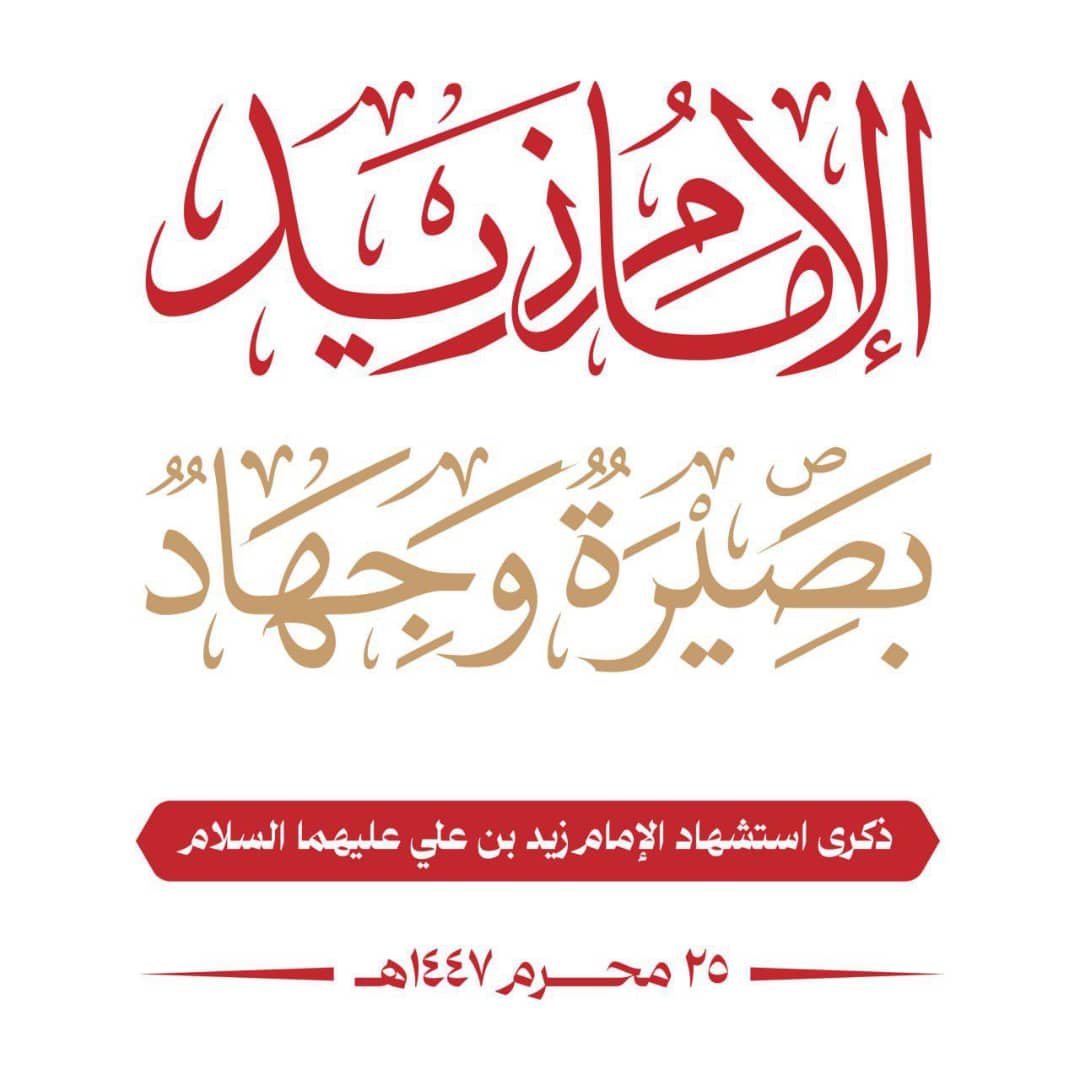Sana’a – SABA Report: Jamil Al-Qashm
The anniversary of the martyrdom of Imam Zayd ibn Ali (peace be upon him) emerges as one of the pivotal stations in the path of revolutionary consciousness for the Ummah. It resurfaces every year in the hearts of the free as a symbol of dignity and a banner of defiance against tyranny. For the Yemeni people, this memory stands as an expression of the natural extension of a deeply rooted jihadist identity in their history and culture.
In the current moment of the Ummah, where confrontation with the enemies of religion and Arab identity intensifies across multiple arenas, this anniversary gains additional dimensions. It transcends sorrowful mourning to become a burning act of mobilization. The presence of Imam Zayd nearly transforms into a core element in the awareness of the cultural front—a guiding light for free peoples seeking dignity and liberation from subjugation.
The anniversary of his martyrdom lives in the conscience of Yemenis as a compass that regains its position whenever the forces of arrogance attempt to shake the awareness of the people. With every new aggression and regional or international conspiracy, the model presented by Imam Zayd in speaking the truth, refusing silence, and rising for God’s cause is revived. This is clearly reflected today in Yemen’s honorable jihadist stance in support of Gaza and against Zionist violations of the Ummah.
Imam Zayd’s revolution embodied the features of an authentic revolutionary school—not seeking power nor chasing authority—but rising in obedience to God’s command to confront falsehood and support the oppressed. This same spirit is carried today by the Yemeni people as they take to the streets, bearing the principles of revolution in support of Palestine, just as Imam Zayd once did.
Those who contemplate the Qur’anic methodology followed by Imam Zayd (peace be upon him) will find it clearly reflected in the vision of the martyred leader, Sayyed Hussein Badr al-Din al-Houthi, who reread Islamic history through the lens of awareness and insight. He examined the revolution of Imam Zayd at length as a moment of exposure for the corrupt Umayyad reality, a station that must be revisited to build the Ummah’s awareness of its true enemies today.
The biography of Imam Zayd occupied a significant space in the Qur’anic lectures delivered by the martyred leader, who presented him as a figure uniting jurisprudence and jihad, knowledge and action—an example that silence before injustice is complicity, and that the Ummah can only rise if its martyrs become eternal beacons in its cultural literature and political behavior.
Revolutionary leader Sayyed Abdul-Malik Badr al-Din al-Houthi is also keen not to let this anniversary pass in any year without recalling it in his speeches, emphasizing that what Yemen is experiencing today in terms of resilience and sacrifices is a natural extension of Imam Zayd’s path and a practical embodiment of his immortal slogan: “No people despised the sword except that they were humiliated”—a slogan that encapsulates the philosophy of dignity and resistance forming the identity of the contemporary Qur’anic project.
This anniversary represents, in the consciousness of Yemen’s cultural front, a station of revival and renewal, where the values of renaissance and sacrifice are revived, and the events of history are linked to the reality of confrontation. The biography of Imam Zayd is not read as a chapter from the past but as an enduring banner and a voice crying from his blood to drive the Ummah toward liberation and confronting arrogance in all its forms and manifestations.
This renewed revolutionary memory has yielded collective awareness among the Yemeni people. Occasions associated with martyrs and leaders have become moments of mobilization and rallying, where past and present struggles are linked. Imam Zayd has become more than a page in a book—he is a spirit in the trenches, a voice in the marches, steps on the frontlines, and an echo repeated in every speech and every moment of honor and dignity.
This living awareness was evident in the massive public response to the events held in various provinces, where slogans of loyalty to the path of Imam Zayd were raised, and his revolutionary words echoed in chants. Simultaneously, a parallel campaign of awareness and mobilization was carried out across media, platforms, and lectures, making this anniversary an act combining emotion and intellect, history and reality.
The anniversary of Imam Zayd’s martyrdom this year intertwined with the Yemeni position in support of Gaza, as if history is repeating itself more clearly. The enemy of yesterday is the same enemy today, and the uprising against Umayyad tyranny then is mirrored today in a progressive stance against the Zionist entity. Revolutionary paths remain the same regardless of time and place, as long as the essence of the battle is truth versus falsehood.
This anniversary comes at a historic moment in which Palestine is facing the ugliest aggression, while most Arab regimes stand as spectators. From the heart of Sana’a and across Yemeni cities, vibrant stances emerge reminiscent of the first cries in Karbala and Kufa—there is no place for cowardice, no option but jihad, and no voice louder than that of righteous resistance, made real through action, stance, and word.
The lessons of Imam Zayd today are seen in the language of confrontation, in the tools of mobilization, and in the framing of revolutionary discourse that doesn’t submit to reality but engages with it, directing it toward truth and redefining the relationship between religion and politics on the basis of the Qur’an and dignity, not surrender and justification under the pressure of weapons and propaganda.
The true depth of commemorating this anniversary lies in reading it not in isolation from the liberation project Yemen is currently leading. Every moment of loyalty to Imam Zayd contains within it a condemnation of silence, a provocation for revolution, and a call to redefine religious values far from submission. This is the message Yemen now carries to all the free people of the world, from its advanced position in the global battle against tyranny.
Today, this anniversary is part of the living political memory of contemporary Yemen. Imam Zayd has become a symbol of revolution—not of sect, of freedom—not of history, of truth—not of jurisprudential interpretations. In this sense, Imam Zayd has become one of the pillars of Yemen’s modern cultural identity, as a historical counterpart to every act of resistance against aggression, dependency, and Zionist-American hegemony over the peoples.
Thus, commemorating Imam Zayd’s anniversary does not end in mourning the past—it begins with awakening, with movement, turning history into fuel for confrontation. Through it, the image of Yemen as envisioned by the martyrs is realized: an unbreakable banner, an unyielding voice, and a principled stance that cannot be bought. Imam Zayd remains, year after year, a beacon of confrontation and an unextinguished flame in the long night of the Ummah.
Amid the grave challenges the Yemeni people face, from ongoing aggression and a blockade led by the U.S., Saudi Arabia, and the UAE, the greatness of the Yemeni stance lies in its refusal to retreat into its wounds. Instead, Yemen has risen above its pain to carry the cause of the Ummah on its shoulders. Its position on the Palestinian struggle is sincere and stems from deep belief, inspired by the flame of Karbala, Zayd’s cry, Hussein’s patience, and the noble legacy of the Prophet’s family.
The revolutionary leadership in Sana’a has proven that commitment to Qur’anic values yields a position that does not disintegrate under siege, nor retreat in the face of aggression. Rather, it becomes more solid and resilient—affirming to the world that Yemen, though deeply wounded, is not broken, and that its revolution is inseparable from the revolutions of Hussein and Zayd. Supporting Gaza is not political—it is a deeply rooted conviction in the conscience of a people who do not bargain with their dignity, nor stand idle in the great battles of the Ummah.

| more of (Reports) |




